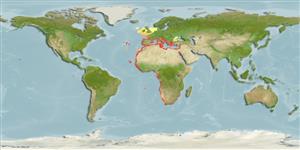Environment: milieu / climate zone / depth range / distribution range
Ökologie
seewasser demersal; tiefenbereich 5 - 500 m (Ref. 5506). Deep-water; ? - 26°C (Ref. 130590); 57°N - 35°S, 32°W - 36°E
Eastern Atlantic: English Channel southward round the Cape of Good Hope to Natal, South Africa (Ref. 4319), including Azores, Madeira and the Canary Islands (Ref. 5506). Also in the Mediterranean and western Black Sea and possibly in the Red Sea (Ref. 5506).
Length at first maturity / Size / Gewicht / Alter
Maturity: Lm 13.7 range ? - ? cm
Max length : 40.0 cm SL Männchen/unbestimmt; (Ref. 5506); common length : 25.0 cm TL Männchen/unbestimmt; (Ref. 36731)
Rückenflossenstacheln (insgesamt) : 10; Rückenflossenweichstrahlen (insgesamt) : 13 - 15; Afterflossenstacheln: 3; Afterflossenweichstrahlen: 7 - 8.
Found on the shelf and upper slope on rocks, Posidonia beds, sand and mud bottoms (Ref. 5506). Adults feed on fishes, cephalopods and crustaceans (Ref. 27121).
Tortonese, E., 1986. Serranidae. p. 780-792. In P.J.P. Whitehead, M.-L. Bauchot, J.-C. Hureau, J. Nielsen and E. Tortonese (eds.) Fishes of the north-eastern Atlantic and the Mediterranean. UNESCO, Paris. vol. 2. (Ref. 5506)
IUCN Rote Liste Status (Ref. 130435)
Bedrohung für Menschen
Harmless
Nutzung durch Menschen
Fischereien: weniger kommerziell; Sportfisch: ja; Aquarium: Kommerziell
Tools
Zusatzinformationen
Download XML
Internet Quellen
Estimates based on models
Preferred temperature (Ref.
123201): 11.2 - 18, mean 14.4 °C (based on 327 cells).
Phylogenetic diversity index (Ref.
82804): PD
50 = 0.5000 [Uniqueness, from 0.5 = low to 2.0 = high].
Bayesian length-weight: a=0.00912 (0.00801 - 0.01038), b=2.98 (2.94 - 3.02), in cm total length, based on LWR estimates for this species (Ref.
93245).
Trophic level (Ref.
69278): 3.4 ±0.3 se; based on diet studies.
Generation time: 5.7 (3.6 - 7.2) years. Estimated as median ln(3)/K based on 13
growth studies.
Widerstandsfähigkeit (Ref.
120179): mittel, Verdopplung der Population dauert 1,4 - 4,4 Jahre. (K=0.1-0.3; tmax=6).
Fishing Vulnerability (Ref.
59153): Moderate to high vulnerability (55 of 100).
Climate Vulnerability (Ref.
125649): Low vulnerability (6 of 100).
Nutrients (Ref.
124155): Calcium = 27.3 [13.7, 76.3] mg/100g; Iron = 0.515 [0.168, 1.123] mg/100g; Protein = 17 [15, 19] %; Omega3 = 0.397 [0.212, 0.744] g/100g; Selenium = 16.3 [6.9, 37.6] μg/100g; VitaminA = 18.4 [3.7, 96.1] μg/100g; Zinc = 0.419 [0.279, 0.660] mg/100g (wet weight);
